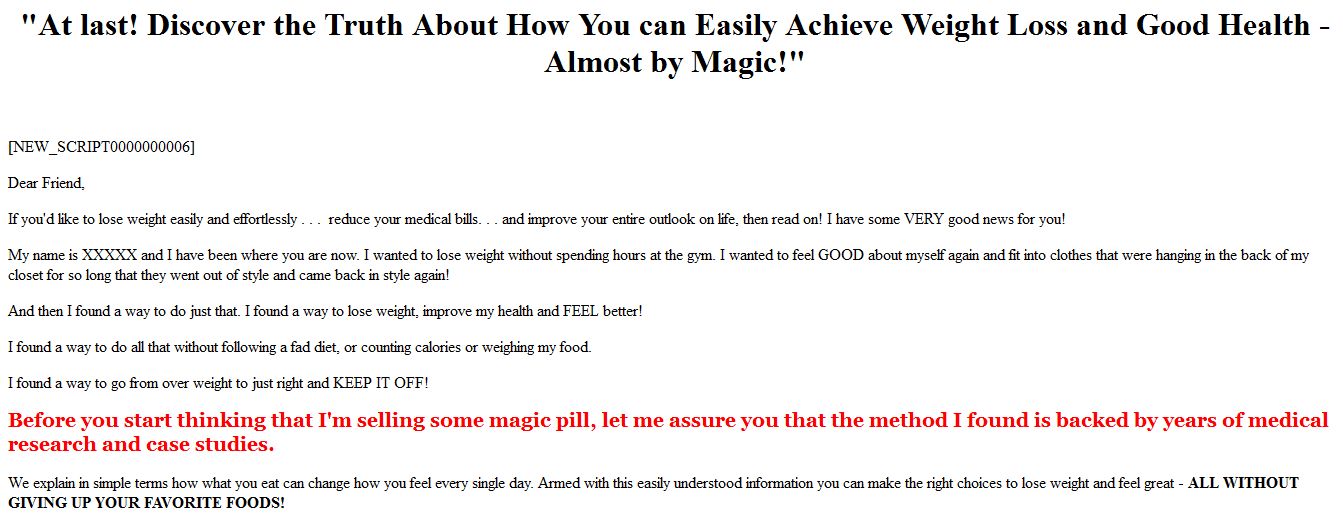Salespage Snapshot:

Table of Contents
Chapter 1: Introduction 3
Chapter 2: What is the Glycemic Index? 4
Chapter 3: How is the Glycemic Index in Foods Determined? 5
Chapter 4: Yes, There are Good Carbs 7
Chapter 5: What are the Effects of Glucose? 8
Chapter 6: The Facts about Insulin 10
Chapter 7: The Glycemic Index and Diabetes Connection 12
Chapter 8: Incorporating the Insulin Index 14
Chapter 9: Glycemic Index Benefits: Weight Loss 16
Chapter 10: Glycemic Index Benefits: Reduced Diabetes Risk 17
Chapter 11: Glycemic Index Benefits: Improved Heart Health 18
Chapter 12: Glycemic Index Benefits: Lower Cholesterol 19
Chapter 13: Go One Step Further with Glycemic Loading 21
Chapter 14: How to Recognize Low Glycemic Index Foods Easily 22
Chapter 15: How to Calculate the Glycemic Load of any Food 23
Chapter 16: Glycemic Index Table of Common Foods 24
FOOD 25
INDEX RATING 25
FOOD 26
INDEX RATING 26
FOOD 27
INDEX RATING 27
Chapter 17: “Do’s” and “Don’ts” of Following a Glycemic Index Diet 29
Chapter 18: In Conclusion 31
Sample Content Preview
Chapter 2: What is the Glycemic Index?
The Glycemic Index is a rating system for foods that gives carbohydrates a numerical value assigned based on its components and how each food affects the body’s sugar levels.
Dr. David Jenkins, a Canadian professor and scientist from the University of Toronto, developed the concept of a rating index in March of 1981. He felt that a better system needed to be developed due to the popularity of diets like Atkins and South Beach that vilify all carbohydrates and many fats. He wanted to show that it is too oversimplified to categorize carbohydrates as “simple” and “complex”, or even worse, as “good carbs” and “bad carbs”. Most carbohydrates are too complex to label them in this manner.
Dr. Jenkins wanted to show the scientific community, and thereby the world, that all foods affect our body blood sugar levels differently and they have different degrees of being simple and complex and good or bad.
Basically, as food breaks down in our digestive system, many of the components, like sugar or vitamins and minerals, are absorbed into our blood stream and immediately affect our system. Foods that break down quickly and have high glucose or sugar levels will give us a “spiked” feeling of energy and euphoria. This feeling is commonly referred to as a “sugar high”. Other foods break down more slowly and release their sugars, starches and nutrients over a longer period of time, which avoids any sudden increases to our sugar levels and keeps our insulin levels low. Later, we will explain exactly what glucose and insulin are and how they affect our bodies and our health.
Dr. Jenkins set out to investigate exactly what happens when the body digests carbohydrates and he did it in the most logical fashion he could think of. He used predetermined amounts of commonly consumed carbohydrates to feed subjects and recorded their blood glucose results after a specified period of time. This fed the researchers sound data upon which they could base their conclusions.
Dr. Jenkins proved that many carbohydrates were, in fact, very healthy and should not be avoided simply because of the fact that they were carbohydrates. As a matter of fact, he discovered that there are dozens of foods that in the past were categorized as unhealthy, but that turned out to be beneficial to our health. He also encountered some surprising results on foods that had always been considered “diet” foods, but when tested, he discovered that they were very high on the Glycemic Index. These surprising results will be uncovered in a few pages.
Dr. Jenkins continues to work in the field of dietary science and pushes forward by continually pursuing the link between diet and health. He proceeds in proving the theory that eating certain diets can improve or eliminate the risk of health issues such as cancer, diabetes, and cardiovascular disease and other diseases.
Chapter 3: How is the Glycemic Index in Foods Determined?
The Glycemic Index uses pure glucose (or in some cases, white bread) as the control food and rates all other carbohydrates in relation to it. The control food, or standard, either the glucose or the white bread, is given a rating of “100” and all other foods are tested as to how they affect a person’s blood sugar, insulin and lipid levels compared to the standard.
Each tested food is given a number rating and defined as either “High”, “Medium” or “Low” on the Glycemic Index. Foods fall into the High Glycemic Index when they are rated at 70 or above. If the Glycemic Index for a food is at 55 or lower, it is considered to be a Low Glycemic Index food item. This means that Medium Glycemic Index foods are those that, after being tested, fall into the range of 56 to 69.
The actual testing to determine a food’s Glycemic Index is very scientific and takes into consideration many test subjects who undergo multiple tests with the same food and with the control, glucose.
A test subject, after fasting for at least 12 hours, will have their blood drawn and tested and then given a specified amount of glucose, usually 50 grams. Their blood is drawn and the blood sugar levels are tested at several specified times throughout the rest of the testing period. This is to determine what the control level is in this individual. Many times, this exact same test of glucose is done two or three times in the same test subject in order to have a more exact result.
After all blood sugar levels have been determined, they are plotted on a graph, which shows the curve of how high the sugar levels rose and also how long they remained elevated. The next step is to take the same individual on another day, after another 12 hour fast, and ask them to eat a sample of the food that will be tested. The amount in grams of carbohydrates in the test food must equal the grams of carbohydrates in the glucose control test.
Depending on the item being tested, the amount of food that the test subject has to eat may be very little, as in the case of foods that are very dense in carbohydrates. On the other hand, the test subject may have to eat an enormous amount of a food that has very little carbohydrates, in order to reach 50 grams of carbohydrates.
Let’s say that the test subject had to ingest pure glucose in the amount of 50 grams of carbohydrates. If the food item being tested were a banana, the test subject would eat the equivalent of 50 grams of carbohydrates in banana. Then, their blood would be drawn and tested at the same times as with the control test with the glucose. The results of their blood sugar levels would be entered on to the same graph as the glucose tests and the results would be compared.
These “banana” tests would be repeated over the next several days with the same test subject to ensure more reliable results. Now, imagine this same testing process with bananas being repeated over and over again with many different test subjects.
This is the testing that is done for every food that has any type of carbohydrate or sugar in it. Thousands of tests have been done to determine the Glycemic Index value of every food.
Going back to our “banana test” – after all of the tests, both the glucose control tests and the specified food tests, have been completed the results are determined. The number for the glucose test is always set at 100 and the food that is being tested and compared to the glucose is graphed and measured against how it affects the person’s blood sugar levels in relation to the glucose.
It was found that banana affects a person’s blood sugar levels only 53% as much when compared to the levels that pure glucose affects them. Therefore, a banana is rated as 53 on the Glycemic Index, which puts it in the Medium Range.
Does that mean that bananas are bad for you and should be avoided? We will discover what the results of the Glycemic Index mean and how to easily incorporate them into your daily food choices later. First, let’s look at the myth that all carbohydrates are bad for you and that they should be avoided at all cost.
Other Details- 1 Ebook (DOCX, PDF, TXT), 32 Pages
- 1 Salespage, Squeeze Page (TXT)
- Affiliate Programs List (DOC)
- Keywords List (XLS)
- Bonus Images (JPG)
- File Size: 676 KB














